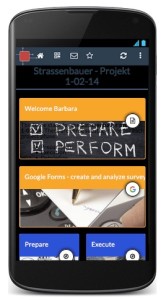Piloting with AchSo and getting feedback on Learning Toolbox – Part Two: Apprentices’ views on using the Learning Toolbox
In my latest blog on the EU-funded Learning Layers (LL) project I started a series of reports on our latest field visits in the construction sector – and in particular in the training centre Bau-ABC. We are now having visitors from Aalto University (Finland)to introduce the tools AchSo and SoAR. In addition, our colleagues from the University of Innsbruck (UIBK) are getting feedback on the use of Learning Toolbox (LTB). In my first post I reported on the introduction of AchSo and how it was received. In my second post I will report on the feedback that apprentices have given using the LTB. Here I just want to give some impressions on the procedure and on the discussions in the groups that I observed. I leave it to the UIBK colleagues to give more detailed account.
The pioneering groups and their learning paths with Learning Toolbox
As I reported in my earlier blogs on the kick-off event of the pilots with Learning Toolbox (LTB) – see my posts of the 3rd of April and of the 6th of April – we started with two trades: carpenters (Zimmerer) and well-builders (Brunnenbauer). With the group of carpenters their trainer Markus Pape had designed a joint project with the trainer of bricklayers (Maurer), Kevin Kuck. This project was about traditional building techniques with wooden frameworks for brick walls (Holzrahmenbau, Fachwerkhäuser). Accordingly, the trainers developed a parent stack that covered the information resources and pointed to specific stacks for the two trades involved in the project and for accessing further knowledge resources. Considering the schedule of the group, they were at the moment having a school period in the nearby vocational school. Afterwards they will continue this project with the bricklayers. During our visit the UIBK colleagues arranged a group discussion with the apprentices at the school.
Concerning the group of well-builders, they started with a project in their own trade. Their trainer Lothar Schoka used the stacks to give them access to selected supplementary materials that are relevant for their project work. In the next phase the group proceeded to neighbouring trades (like machine and metal techniques or pipeline building) in which they get the foundation level training. At the moment they were having a period in Bau-ABC with metal technique. Thus, also the feedback on the use of LTB could be implemented alongside their work with the elementary exercises. Below I will give insights into feedback collected from discussions with this group.
Apprentices’ views on uses of LTB in training centre and in real work situations
The UIBK colleagues put on the board small posters that presented statements picked up from the kick-off event in March. Each statement expressed expectations on benefits of using the LTB. Now each participant had the chance to give votes, which of these expectations had come true – and which he would see as the most important (first, second, third). Here I could see in two groups, how the votes concentrated on a few statements. We were somewhat surprised that the apprentices found LTB easy to use – once the initial difficulties had been overcome. Also, given the relatively limited amount of stacks (and the structure of stacks for their domain) they found it easy to search the information they needed. Also, the chat function was praised as a functioning hotline for passing quick messages to trainers (although this was dependent on the online presence of individual trainers). Furthermore, the LTB was seen as a good tool to have an overview on the learning contents and on keeping the contents available (as priority contents) when needed.
After several positive remarks on the use of LTB as such, the apprentices in all groups made the point that they see the major benefits in using LTB in the intermediate training arrangements in Bau-ABC – which is primarily a learning environment. In the companies there are less people around, questions and answers are passed more directly, there is less chance to do searches and there is more time pressure. Furthermore, there is less tolerance for mistakes or discussing them on the web (privacy and data protection aspects). Partly these reservations are related to generation issues – younger construction site managers are more positive than older.
Then the UIBK colleagues asked, whether the apprentices would prefer to carry out their projects entirely with paper-based documentation or with LTB (if the latter option would be available). In this context the apprentices in all groups voted almost unanimously for the LTB option.
Finally, the UIBK colleagues asked about their expectations on using AchSo. Here they also emphasised the use in Bau-ABC. They drew attention to the possibility to focus on very small but important details or on points in which most mistakes are being made. They also referred to different potential in manual work as well as in complex activities with heavy machinery. They also pointed to the possibility to use video to facilitate the learning processes of those, who do not speak German as their mother tongue. In some groups there were discussions on the use of AchSo in instruction videos (prepared by trainers) and documentation of learning (prepared by apprentices). Altogether, the apprentices saw quite a number of possibilities. Yet, there was a tension between the fact that they have to complete their projects individually, whilst the use of videos requires cooperation with their peers.
– – –
I think this is enough at the moment. The UIBK colleagues will work more thoroughly through the material. But as a first impression this feedback already shows that the work with LL tools is received well and that both trainers and apprentices are making progress. In my next post I will report on the presentation of the SoAR tool (SocialAugmented Reality) by the Aalto colleagues in a further session in Bau-ABC.
More blogs to come …

